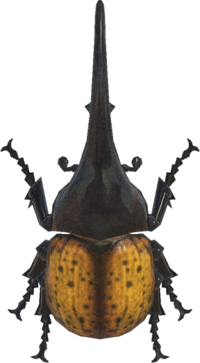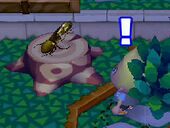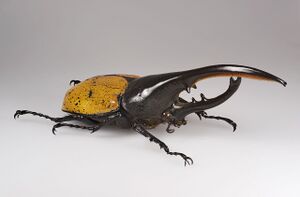Horned hercules
- "I caught a hercules beetle! The largest beetle in the world!" —Wild World
- "I caught a hercules beetle! It's the greatest beetle of them all!" —City Folk
- "I caught a horned hercules! Who's the mighty one now?" —New Leaf
The Horned Hercules[nb 1] (known as the Hercules Beetle prior to New Leaf), is a bug in the Animal Crossing series introduced in Doubutsu no Mori e+. It is tied with the Golden Stag and the Giraffe Stag as the most valuable bug in the Animal Crossing series, selling for 12,000 Bells.
Catch details
Wild World
| 64px | ''The largest beetles in the world."
|
City Folk
In Pocket Camp
| Availability | Not currently available
|
|---|---|
| Location | |
| Size | 146.9 mm - 172.9 mm |
| Rarity | ★★★ |
| Selling price | |
| Version added | Unknown |
| Villager gift data | Tier: Unknown
Rewards: Unknown |
In New Horizons
| Time of year | North: Jul – Aug South: Jan – Feb |
|---|---|
| Time of day | 5 PM – 8 AM |
| Location | On palm trees |
| Weather | Any weather |
| Spawn requirement | Catch 100 total bugs |
| Selling prices | |
| Furniture size |
Donating to the museum
Blathers makes these comments when the insect is donated to the museum.
In Wild World
"The hercules beetle is known as the largest beetle in the world, eh wot? It's those mammoth horns! Yes, the horns are its claim to fame... But inspect them, and you'll see they're covered in hair! Blech! Hairy horns... Frankly, I can't think of anything more vile..."
In City Folk
"Hoo now... The largest dynastid beetle around! I must say, those horns are simply magnificent! Dynastid beetles move fairly slowly, so you're free to view them at your own pace, eh wot? I must heartily endorse any insect that has the decency to move slowly and predictably. Well done!"
After donation, the Hercules Beetle can be found on the second tier of the insect section in the first enclosure, walking on the tree stump towards the back. Once the Golden Stag has also been donated, both will fight on the stump, picking each other up and tipping one another over.
In New Leaf
In New Leaf, the Horned Hercules is found in the right-hand back room on the large tree stump in the center. If the Golden Stag is also donated, the two will be fighting each other. The exhibit has this to say about the Horned Hercules:
"Horned herculeses are the largest beetles in the world, reaching over 17 cm in exceptional cases. Their 2 long horns look pretty, but they're powerful and can hurt a lot if you're pinched by them. The longer horn is covered with short, soft yellow hair, which helps them to sense vibrations. The yellow on their bodies turns black when it's humid, making them difficult to spot on humid evenings."
In New Horizons
"The horned hercules is not only known for its tremendous strength, but for its size as well. It can grow up to seven-inches long and has powerful pincers covered in hair that help with gripping! As if this weren't ghastly enough, these behemoth beetles let loose a foul odor that fends off enemies... And offends my sense of smell.
Further Information
The hercules beetle is the most famous and largest of the rhinoceros beetles. It is native to the rainforests of Central America and South America. The size of this beetle includes the length of its horn, which without, would make it ranked lower down - some females (which are considerably smaller excluding the horn), can exceed the size of the male Hercules beetle by body alone. The hercules beetle is considered the strongest creature on earth relative to its size - it can handle 850 times its own body weight. They eat decaying fruit and the larvae of the beetle spends one to two years tunneling into rotten wood.
Names in other languages
| ヘラクレスオオカブト herakuresu-ō-kabuto |
Lit. "Heracles giant helmet (bug)" | |
| 헤라클레스장수풍뎅이 herakeulleseujangjupungdeng-i |
Lit. "Heracles rhinoceros beetle" | |
| 长戟大兜虫 chángjǐ dàdōuchóng |
Lit. "Long-speared giant helmet bug" | |
| 長戟大兜蟲 Unknown |
||
| Жук-геркулес Zhuk-gerkules |
Lit. "Hercules beetle" | |
| Herculeskever | Lit. "Hercules beetle" | |
| Herkuleskäfer | Lit. "Hercules beetle" | |
| Escarabajo astado hércules | Hercules horned beetle | |
| Scarabée Hercule | Lit. "Hercules scarab" | |
| Scarabeo Ercole | Lit. "Hercules scarab" | |
Notes
| Bugs | ||||||||||||||||||||||||||
|---|---|---|---|---|---|---|---|---|---|---|---|---|---|---|---|---|---|---|---|---|---|---|---|---|---|---|
| ||||||||||||||||||||||||||


